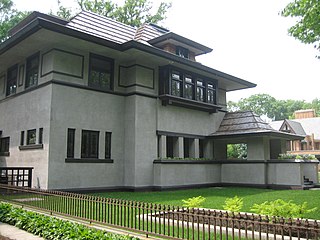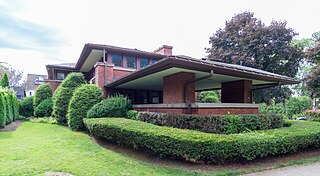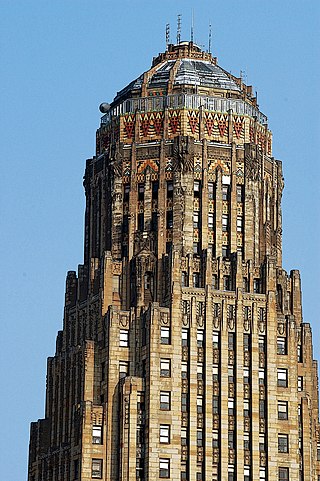
Frank Lloyd Wright Sr. was an American architect, designer, writer, and educator. He designed more than 1,000 structures over a creative period of 70 years. Wright played a key role in the architectural movements of the twentieth century, influencing architects worldwide through his works and mentoring hundreds of apprentices in his Taliesin Fellowship. Wright believed in designing in harmony with humanity and the environment, a philosophy he called organic architecture. This philosophy was exemplified in Fallingwater (1935), which has been called "the best all-time work of American architecture".

The Robie House is a historic house museum at 5757 South Woodlawn Avenue in the Hyde Park neighborhood of Chicago in Illinois, United States. Designed by the architect Frank Lloyd Wright in the Prairie style, it was completed in 1910 for the manufacturing executive Frederick Carlton Robie and his family. George Mann Niedecken oversaw the interior design, while associate architects Hermann von Holst and Marion Mahony also assisted with the design. The Robie House has been described as one of Wright's best Prairie style buildings and was one of the last structures he designed at his studio in Oak Park, Illinois.

The Price Tower is a nineteen-story, 221-foot-high (67 m) tower at 510 South Dewey Avenue in Bartlesville, Oklahoma, United States. One of the few skyscrapers designed by Frank Lloyd Wright, the Price Tower is derived from a 1929 proposal for apartment buildings in New York City. Harold C. Price Sr., the head of the pipeline-construction firm H. C. Price Company, commissioned the Price Tower. The building was widely discussed when it was completed in 1956. In addition, the Price Tower received the American Institute of Architects' Twenty-five Year Award in 1983, and it has also been designated as a National Historic Landmark.

The Ward W. Willits House is a home in Highland Park, a suburb of Chicago in Illinois, United States. Designed in 1901 by architect Frank Lloyd Wright, the Willits house is considered one of the first of the great Prairie School houses. The house presents a symmetrical facade to the street and has a cruciform plan, with four wings extending out from a central fireplace. In addition to stained-glass windows and wooden screens that divide rooms, Wright also designed the furniture for the house.

Unity Temple is a Unitarian Universalist church in Oak Park, Illinois, and the home of the Unity Temple Unitarian Universalist Congregation, which originally formed in 1871. It was designed by the American architect Frank Lloyd Wright, and built between 1905 and 1908. Unity Temple is considered to be one of Wright's most important structures dating from the first decade of the twentieth century. Because of its consolidation of aesthetic intent and structure through use of a single material, reinforced concrete, Unity Temple is considered by many architects to be the first modern building in the world. This idea became of central importance to the modern architects who followed Wright, such as Ludwig Mies van der Rohe, and even the post-modernists, such as Frank Gehry. The church is designated as a National Historic Landmark and is part of "The 20th-Century Architecture of Frank Lloyd Wright", a World Heritage Site.

The Johnson Wax Headquarters is the corporate headquarters of the household goods company S. C. Johnson & Son in Racine, Wisconsin, United States. The original headquarters includes two buildings designed by Frank Lloyd Wright: the Administration Building, completed in April 1939, and the Research Tower, completed in November 1950. The headquarters also includes the Golden Rondelle Theater, relocated from the 1964 New York World's Fair, in addition to Fortaleza Hall and The Commons, a memorial to Samuel Curtis Johnson Jr.. Both of the original buildings were widely discussed when they were completed, and they have been depicted in several exhibits and media works. In addition, the original headquarters has received the American Institute of Architects' Twenty-five Year Award and has been designated as a National Historic Landmark.

The Darwin D. Martin House is a historic house museum in Buffalo, New York. The property's buildings were designed by renowned architect Frank Lloyd Wright and built between 1903 and 1905. The house is considered to be one of the most important projects from Wright's Prairie School era.

The George F. Barton House was designed by Frank Lloyd Wright, built 1903–1904, and is located at 118 Summit Avenue in Buffalo, New York. The Barton House is part of the larger Darwin D. Martin House Complex, considered to be one of the most important projects from Wright's Prairie School era.

The Wainwright Building is a 10-story, 41 m (135 ft) terra cotta office building at 709 Chestnut Street in downtown St. Louis, Missouri. The Wainwright Building is considered to be one of the first aesthetically fully expressed early skyscrapers. It was designed by Dankmar Adler and Louis Sullivan and built between 1890 and 1891. It was named for local brewer, building contractor, and financier Ellis Wainwright.

The Pope–Leighey House, formerly known as the Loren Pope Residence, is a suburban home in Virginia designed by American architect Frank Lloyd Wright. The house, which belongs to the National Trust for Historic Preservation, has been relocated twice and sits on the grounds of Woodlawn Plantation, Alexandria, Virginia. Along with the Andrew B. Cooke House and the Luis Marden House, it is one of the three homes in Virginia designed by Wright.

The Graycliff estate was designed by Frank Lloyd Wright in 1926, and built between 1926 and 1931. It is approximately 17 miles southwest of downtown Buffalo, New York, at 6472 Old Lake Shore Road in the hamlet of Highland-on-the-Lake, with a mailing address of Derby. Situated on a bluff overlooking Lake Erie with sweeping views of downtown Buffalo and the Ontario shore, it is one of the most ambitious and extensive summer estates Wright designed. It is now fully restored and operates as a historic house museum, open for guided tours year round. There is also a summer Market at Graycliff, free and open to the public on select Thursday evenings. Graycliff Conservancy is run by Executive Director Anna Kaplan, who was hired in 2019.

The Edward R. Hills House, also known as the Hills–DeCaro House, is a residence located at 313 Forest Avenue in the Chicago suburb of Oak Park, Illinois. It is most notable for a 1906 remodel by architect Frank Lloyd Wright in his signature Prairie style. The Hills–DeCaro House represents the melding of two distinct phases in Wright's career; it contains many elements of both the Prairie style and the designs with which Wright experimented throughout the 1890s. The house is listed as a contributing property to a federal historic district on the U.S. National Register of Historic Places and is a local Oak Park Landmark.

The William R. Heath House was designed by Frank Lloyd Wright, built from 1903 to 1905, and is located at 76 Soldiers Place in Buffalo, New York. It is built in the Prairie School architectural style. It is a contributing property in the Elmwood Historic District–East historic district and a City of Buffalo landmark.

The Robert M. Lamp House is a residence built in 1903 two blocks northeast of the capitol in Madison, Wisconsin, designed by Frank Lloyd Wright for his lifelong friend "Robie" Lamp, a realtor, insurance agent, and Madison City Treasurer. The oldest Wright-designed house in Madison, its style is transitional between Chicago School and Prairie School. In 1978 the house was added to the National Register of Historic Places.

The Walter V. Davidson House, located at 57 Tillinghast Place in Buffalo, New York, United States, was designed by Frank Lloyd Wright and built in 1908. It is an example of Wright's Prairie School architectural style. The house is a contributing property to the Parkside East Historic District, a neighborhood laid out by renowned American landscape architect Frederick Law Olmsted in 1876, and also a City of Buffalo landmark.

The Architecture of Buffalo, New York, particularly the buildings constructed between the American Civil War and the Great Depression, is said to have created a new, distinctly American form of architecture and to have influenced design throughout the world.

The David and Gladys Wright House is a residence at 5212 East Exeter Boulevard in the Arcadia neighborhood of Phoenix, Arizona, United States. Designed by Frank Lloyd Wright in an organic style for his son David and daughter-in-law Gladys, it was built from 1950 to 1952. In the 2010s, the house was one of four remaining buildings designed by Frank Lloyd Wright in Phoenix and one of nine such buildings in Arizona. In addition to the main house, the site includes a small guesthouse to the northeast. It is listed on the National Register of Historic Places.

John Durrant Larkin was an American business magnate who pioneered the mail-order business model, developed the marketing strategy of offering premiums to customers, introduced revolutionary employment innovations, and commissioned Frank Lloyd Wright's first major public work, the Larkin Administration Building.

The Larkin Company, also known as the Larkin Soap Company, was a company founded in 1875 in Buffalo, New York as a small soap factory. It grew tremendously throughout the late 1800s and into the first quarter of the 1900s with an approach called "The Larkin Idea" that transformed the company into a mail-order conglomerate that employed 2,000 people and had annual sales of $28.6 million in 1920. The company's success allowed them to hire Frank Lloyd Wright to design the iconic Larkin Administration Building which stood as a symbol of Larkin prosperity until the company's demise in the 1940s.

Larkinville, also known as The Hydraulics, is an area of Buffalo, New York located near downtown, South Buffalo and Canalside. Once an industrial neighborhood, it is now home to offices, shops, and a public gathering space called Larkin Square that regularly features food trucks, events, and concerts. The current form of the neighborhood came as a result of the gentrification of the former headquarters complex of the Larkin Soap Company, which includes the Larkin Terminal Warehouse, and other abandoned warehouses nearby.























